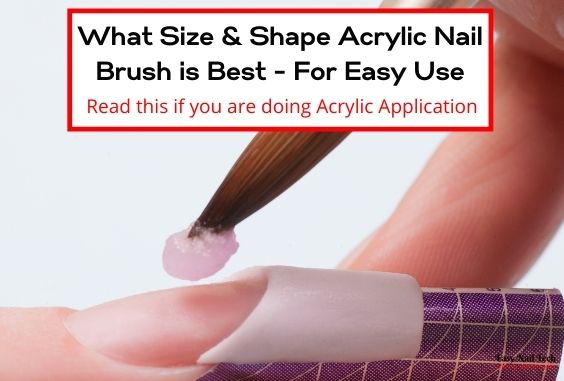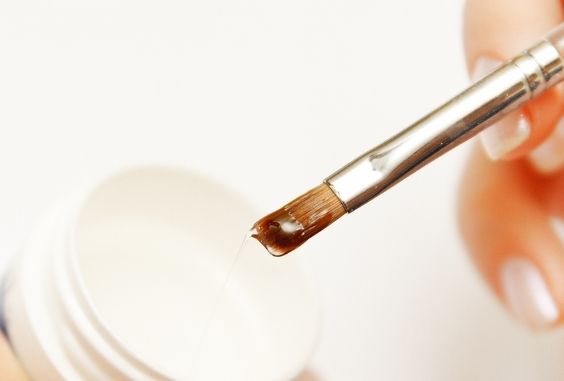What Size & Shape Acrylic Nail Brush is Best – Easy to Use

Applying acrylic can be very tedious especially sculpting and getting the right liquid to powder ratio. Now choosing the right size and shape of acrylic nail brush can really help make application easier and faster.
That’s why in this article I am gonna guide you through the different sizes and shapes of acrylic nail brushes to help you decide which one is right for you.
What Size of Acrylic Nail Brush is Best For Beginners
Acrylic Nail Brushes come in a wide variety of sizes from number 2,4,6,8,10,12,14,16,18,20,22,24. Now the larger the size the larger the brush will be.
The best sizes of acrylic nail brushes for beginners are medium-sized, between 6 or 8. These two sizes are big enough to allow you to quickly and easily cover the nails yet small enough for you to easily control & allow you to be detailed.
Now what I recommend is that you start off with a medium-size brush, and then you gradually work your way to a larger brush like 10 & above which requires more experience but allows for faster application.
Small brushes such as 2,& 4 are great for detailing work such as nail art & in-fills.
What Shape of Acrylic Nail Brush is Best For Beginners
Oval-shaped acrylic nail brushes are the best for acrylic application, both for beginners and veterans. Oval-shaped brushes allow you to make nice beads with a good liquid to powder ratio and allow for easy sculpting.
Best Type of Bristle For Acrylic Nail Brushes
Acrylic Nail Brushes made of natural fibers such as Kolinsky and Sable are the best type of acrylic nail brush for both professionals and beginners.
These bristles are the best because:
- They can easily hold the liquid monomer allowing you to pick up better beads.
- They form into a nice shape – with a fuller body and a fine tip perfect for sculpting.
Synthetic bristles can work but tend to perform sub-par compared to natural fibers. Synthetic brushes are better for gel application.
7 Tips to Quickly Heal Damaged Nails After Acrylic Or Gel
Best Acrylic Nail Brush For Beginners
I have two great recommendations if you are new to applying acrylic nails:
1- Pana Size 8 Oval Kolinsky Brush – is a premium and very durable brush that is ideal for beginners.
You can click here to see the price for one on Amazon.
2-Modelones Size 8 Oval Kolinsky Brush – is great if you are on a tight budget.
Amazon usually has them at bargain prices, you can click here to check them out.
Chart Showing Different Sizes of Acrylic Nail Brushes
| Size of Acrylic Brush | Who Should Use them | Uses |
| Size 2, & 4 | Can be used by both beginners and experienced nail techs | Sizes 2 & 4 are small brushes that are best used for either working on very small nails or doing detailed work like nail art or in-fills. |
| Size 6 & 8 | Sizes 6 & 8 are medium size brushes, that are easy to use, they are ideal for beginners | Sizes 6 & 8 are small enough to do detailed work and large enough to do sculpting in a timely manner. |
| Sizes 10 & Higher | Sizes 10 & Higher are large brushes that are best used by more experienced nail techs | Larger sizes allow for very quick application and are ideal for creating extra-long extensions |
Video Showing Difference of A Big Acrylic Nail Brush Vs A Small One
How Does the Size of Acrylic Brushes Affect Acrylic Application
The brush size affects:
- The size of the beads created
- Ease of application
- Liquid to powder ratio
- How much detailing you can do
- How likely is the monomer can come into contact with skin
- Speed of Application
10 Reasons Why Acrylic Nails Lift & How to Fix & Prevent
1- Size of the Bead
The size of your acrylic nail brush will affect how big your acrylic beads are. The larger the brush the bigger the beads tend to be.
Larger brushes have more surface area which tends to hold more monomer (liquid). And because it has more liquid monomer it can pick up more powder thus creating larger beads.
The advantages of larger beads are:
- They allow for faster application – since you don’t need to constantly be making more beads.
- Acrylic nails that are made from less beads are stronger – you see less beads used means that the all of the acrylic mixture hardens at the same time. This creates a uniform structure making a stronger nail.
Now the main drawbacks with large beads are:
- They are harder to control and sculpt
- Larger beads can lead to you applying too much acrylic – which means you might need to do alot of filing to get rid of excess.
This is why it’s recommended that beginners create smaller beads. Smaller beads are easier to manage since you can sculpt in sections and have more control over the amount of acrylic applied.
Nail Forms Vs Tips – Which One is Really Better & Stronger
2- Ease of Use
Smaller acrylic brushes tend to be easier to use and control. Whilst the larger the brush is, the more skill and practice you require to master it.
Think of the difference when you use a small knife compared to a large chopper. The smaller it is the more control over the movements you have especially when working within small spaces like your nails.
3- Liquid to Powder Ratio
It’s important to note that the size of the brush affects the liquid-to-powder ratio. So if you are switching the size of your brush you need to experiment with your beads before applying them to yourself or on a client.
Smaller acrylic brushes tend to be easier to get the right liquid to powder ratio. Whilst larger brushes you need to ensure that you dont pick up too much liquid or at least ensure you pick up enough powder to balance out the liquid.
You see larger brushes absorb and hold more liquid monomer. And if you are a beginner and you don’t yet have a good average this can cause your beads to be very watery.
Can You Use Substitutes Instead of Monomer Acrylic Nails
3- Detailing
Smaller brushes like sizes 2 & 4 allow you to do more detailed work like nail art or doing in-fills (which is filling the gap at the back of your nails made from nail growth).
This is because they have small tips that can function like pens or pencils allowing you to work on a small area.
Acrylic Overlay Nails: Everything You Need to Know
4- Contact with Skin
The larger the acrylic brush is the more likely it is to touch your skin or cause some of the acrylic to go onto your skin.
Now if monomer or the acrylic mixture goes on the skin it can lead to irritation or worst an allergic reaction.
Small brushes give you more control which helps to keep the brush from touching your skin.
When to Remove Acrylic Nails & When to Get it Filled
5- Speed of Sculpting
Larger brushes are faster at sculpting because:
- they allow you to quickly move the acrylic into place with less movement and effort
- Requires fewer beads since they create larger beads.
How Much is an Acrylic Fill & How Long Does it Take
Cost of Acrylic Nail Brushes
The larger the size of the brush is, the more it will cost.
Types of Shapes of Acrylic Nail Brushes
Acrylic Nail Brushes come in different shapes, the 3 most common types are:
- Flat Square Brushes
- Round Brushes
- Oval Brushes (Most recommended shape of acrylic nail brush)
1- Flat / Square Brushes

Flat Brushes are best at applying a small amount of acrylic to the cuticle area. This is because flat brushes dont hold much acrylic and the edges can be used to maneuver in a small space like your cuticle area.
Now the main issue with square brushes is that they struggle to hold enough liquid monomer so the beads tend to be too thick and dry.
2- Round Brushes
Rounds brushes are the original and most common type of acrylic nail brushes. These brushes tend to hold enough monomer so you get a good liquid-to-powder ratio to make good beads.
3- Oval Brushes
Oval-shaped brushes give you the best of both round and squared brushes.
They are shaped like a round brush so they hold enough monomer to give you a nice balanced bead. But the tip is flat allowing for more detailed work and faster sculpting.
Pro-Tip
You need to keep your acrylic nail brushes in condition for them to work effectively and to do you need to safely clean them.
Now I have an entire article that will guide you through how to clean your acrylic brushes safely and quickly without having to use monomer.
Citation & References
